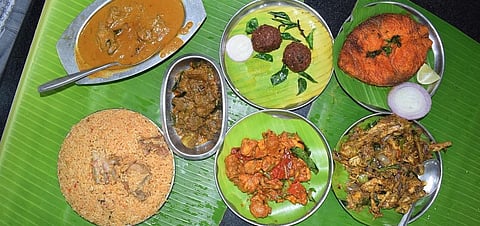

CHENNAI: Kongunadu cuisine — a lesser-known cuisine of Tamil Nadu — is native to the Kongu belt, located in the north-western region of the state, and includes Salem, Tiruppur, Mettur, Erode, and Coimbatore. The word kongu means nectar or honey and the people, food, and their slang live up to this. Evidence of Paleolithic burial sites coupled with the legend that the Roman togas have roots here indicates a rich history. The rulers of the region over time namely the Cheras, Gangas of Talakad, Cholas, and Madurai Nayaks have influenced the cuisine. During the time of the Cheras, minimal spices were used and every ruling dynasty over the centuries brought in new spices to the cuisine. Agriculture is made possible by Cauvery’s tributaries like Noyyal and Siruvani, and the arid areas influence the region’s food habits. Kongu cuisine reflects the geography revolves around freshwater fish, goat, poultry, turmeric, and tapioca. Before the Green Revolution brought in rice as a staple, this region’s dishes included millets like ragi, jowar, and kambu.
As Kongu Nadu grows the best turmeric, most dishes feature this freshly grated or powdered ingredient, giving it a beautiful hue. Several dishes are spiced with shallots, red chillies, and a sprinkle of pepper, jeera and they are wonders of simplicity packed with flavours. Sesame and coconut are abundant, and hence, these oils are predominantly used. Kongu food is a typical example of terroir-based cuisine and the cornucopia of ingredients is tightly knit in the culinary traditions. Meat is never marinated; this retains natural flavours and renders the food rustic. Look no further than the perfect examples of Pallipalayam chicken, Chinthamani chicken, and mutton salavu kolambu.
Often, grains are used in various forms in regular meals ranging from ragi kali, koozhu, chola soru, dosai to paniyaram. Tapioca, a staple, is eaten steamed or as dosai, vadai, or sago. Culinary tips unique to the area include adding castor seeds to idli batter for soft idlis, and castor oil while cooking dals and meat to soften them and quicken the cooking process.
A typical day begins with a healthy and light breakfast like ragi koozhu (being fermented, it improves gut health), pillowy paniyarams, or idlies. For lunch, arisi paruppu sadam is the ultimate comfort food. This one-pot meal with rice, dal, shallots, and spices — cooked in a jiffy — is a winner any day when served hot with ghee and vadams. The subtly-spiced Kongu Vella biryani with short-grain rice proves to be a tough competitor to spicy ghee-laden counterparts. Kollu or horsegram is eaten frequently here. Recently, many have started using this for its nutritional value.
The minimalist trend extends beyond spices and whipping up two dishes from the same ingredient is a norm here. For example, a watery meat kolambu for breakfast can be converted, after removing the meat, to a fry after sautéing with spices. Dinner is usually a simple affair with various types of sevai, idli, or dosai. Speaking of desserts, obattu (poli), kachayam (adhirasam), sago or cotton seed milk payasam rule the roost.
The now-popular creamy non-spicy, nutty Japan chicken is a significant addition to the cuisine. Invented in Tiruppur to suit the palates of the foreign delegates who arrived there for business, this dish utilises abundant dairy products. While there is nothing Japanese about this dish, it is a sought-after one. Locally grown vegetables are used. Yellow pumpkin is common and is aptly called Arasanikkai (king of vegetables). This tangy flavoursome Kongu arasanikai (pumpkin) kulambu curry ticks all your flavour boxes:
Kongu
Arasanikai Kulambu
Ingredients
For masala paste
Shallots: 6
Garlic: 6
Tomato: 1
Jeera: 1 tsp
Fenugreek: 1/4tsp
Coriander seeds: 1 tbsp
Red chillies: 6
Grated coconut: 3 tbsp
For curry
Shallots: 6
Curry leaves: a sprig
Pumpkin: 1 cup
Mustard seeds: 1 tsp
Marble-sized tamarind
Gingelly oil: 3 tbsp
Jaggery: 1 tsp
Turmeric: 1/2 tsp
Method
In a teaspoon of oil, fry all the ingredients. Cool and grind to a paste. Heat oil, add mustard seeds, shallots, curry leaves, turmeric, and sauté for a few minutes. Add the paste, and salt and sauté for five minutes. Add pumpkin, water, salt, and cook. Add the tamarind water and jaggery and cook for 10 minutes till you get the desired consistency. Serve with hot rice.